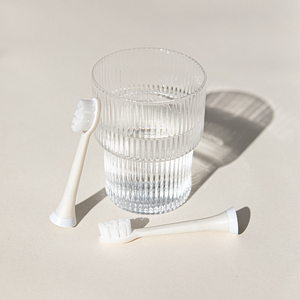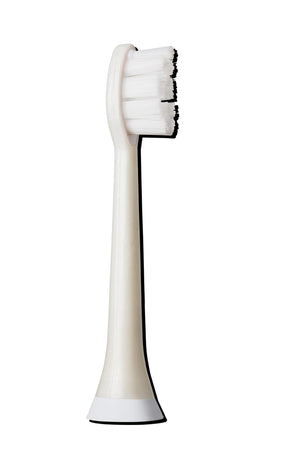Your Cart is Empty
FREE U.S. Shipping $65+ |VIEW SHOP HOURS




The Bristles
The same dentist designed rounded wave-shaped bristles as our bamboo toothbrushes. Made of soft natural nylon and free of color dyes.
The Handle
Sustainable, biodegradable, cornstarch with a metal ring at the base (for durability and to conduct the vibration). Compatible with most click-on Phillips Sonicare toothbrushes.
PLUS ULTRA is a female-founded brand. They are rooted in sustainability, eco-conscious production, and philanthropy.
Care: Doctors recommend replacing your toothbrush head every 3-4 months or after an illness.
End-of-Life:The base; curbside compost bin aka industrial facility compost bin. Pop the metal ring at the base; recycle bin. Remove bristles; trash bin.
Designed to the specifications of dentist recommendations, the bristle heads feature a wave-shaped design that cleans difficult-to-reach areas with soft, nylon bristles that gently massage the gum line.
FAQs
Q: I don’t have curbside compost available in my area. How do I dispose of the brush head?
A: If composting is not available in your area you can put the entire head in the trash and 99% of it will degrade in the landfill.
Q: I've seen other products on the market made of bamboo. Why isn't this brush head made of bamboo?
A: This product spent 2 years of R&D testing materials and their durability. Bamboo didn't work - at all. the vibration it gave off was far too harsh causing the bristles to fall out and the head to eventually crack right open. If you see bamboo brush heads out there they are likely a plastic laminate made to look like bamboo or plastic on the inside with a laminate facade
Q: How does the cornstarch brush base get composted in an industrial compost facility?
Heat, water, nitrogen, oxygen, and microorganisms all play a part in how fast something will biodegrade. And, in an industrial facility, there are two steps that need to happen to biodegrade cornstarch-based PLA properly; disintegration and biodegradation.
In the disintegration step, the moisture and heat in the compost pile split the polymer chains apart, creating smaller polymers, and finally, lactic acid.
During the biodegradation step microorganisms in compost and soil consume the smaller polymer fragments and lactic acid as nutrients. Since lactic acid is widely found in nature, a large number of organisms metabolize lactic acid. The end result of composting is carbon dioxide, water, and humus; a soil nutrient.
This degradation process is temperature and humidity-dependent which can be controlled at an industrial facility but almost impossible to achieve in a DIY backyard composter.
Q: Can I put it in my backyard compost bin?
A: Yes. However, as stated above, it will take considerably longer to biodegrade because we can’t get our home compost to the high humidity and high heat temperatures needed to biodegrade as fast as an industrial facility.